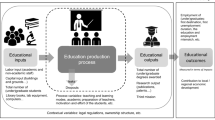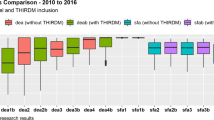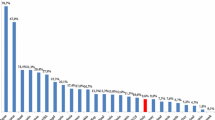Abstract
In this study we have used data from Spanish public universities to assess their efficiency in a longitudinal framework between 2008/9–2014/15. To carry out the analysis, two windows data envelopment analysis and intertemporal, non-radial and radial analysis methodologies were compared. The main results show a significant deterioration in university efficiency from the 2012/13 academic year for the three proposed frontiers, with both methodologies. Some factors may explain these results, such as the ageing of teaching force and its low replacement rate of 10%, and the lack of incentives for young researchers who wish to pursue a research career, influenced by the presence of endogamy, in hiring or promotion. Finally, the resources necessary for the good governance of the Spanish public university with the consequent accountability of these, in terms of teaching, research and its transfer to society, could become a strategic issue that should be taken into account by all the actors involved.




Similar content being viewed by others
References
Abbott, M., & Doucouliagos, C. (2003). The efficiency of Australian universities: A data envelopment analysis. Economics of Education Review, 22, 89–97.
Abramo, G., D’Angelo, C. R., & Pugini, F. (2008). The measurement of Italian universities ‘research productivity by a non-parametric-bibliometric methodology. Scientometrics, 76(2), 225–244.
Agasisti, T., & Bolli, T. (2013). The impact of the Bologna reform on the productivity of Swiss universities. Higher Education Quartely, 67(4), 374–397.
Agasisti, T., & Dal Bianco, A. (2009). Reforming the university sector: Effects on teaching efficiency-evidence from Italy. Higher Education, 57(4), 477–489.
Ahn, T. (1987). Efficiency and related issues in Higher Education: A Data Envelopment Analysis approach, Ph. D. dissertation, Collage and Graduate School of Business, University of Texas, Austin.
Ahn, T. & Seirford, L. (1993). Sensitivity of DEA models and variable sets in a hypothesis test setting: The efficiency of university operations, en Ljiri (ed).
Angulo, M. L., Correia, B. S. de Mello J. C., Figueiredo G. J. S., & Moren P. (2018). Evaluation of post-graduate programs using a network data envelopment analysis model. DYNA, 85, 83–90.
Aparicio, L., Cordero, J. M., Gonzalez, M., & Lopez-Espin, J. J. (2017). Using non-radial DEA to assess school efficiency in a cross-country perspective: An empirical analysis of OECD countries. Omega, 1–12.
Athanassopoulos, A., & Shale, E. (1997). Assessing the comparative efficiency of higher education institutions in the UK by means of data envelopment analysis. Education Economic, 5(2), 117–134.
Avkiran, N. (2001). Investigating technical and scale efficiencies of Australian universities through data envelopment analysis. Socio-Economic Planning Sciences, 35, 57–80.
Badunenko, O. & Mozharovskyi, P (2016). Nonparametric frontier analysis using stata. Stata Journal
Banker, R. D., Charnes, A., & Cooper, W. W. (1984). Some models for estimating technical and scale efficiencies in data envelopment analysis. Management Science, 30(9), 1078–1092.
Barra, C., Lagravinese, R., & Zotti, R. (2018). Does econometric methodology matter to rank universities? An analysis of Italian higher education system. Socio-Economic Planning Sciences, 62, 104–120.
Bolli, T., & Farsi, M. (2015). The dynamics of productivity in Swiss universities. Journal Productivity Analysis, 44, 21–38.
Charnes, A., & Cooper, W. W. (1985). Preface to topics in data envelopment analysis. Annals of Operations Research, 2, 59–94.
Charnes, A., Cooper, W. W., & Rhodes, E. (1978). Measuring the efficiency of decision making units. European Journal of Operational Research, 2, 429–444.
Comisión de Expertos para la Reforma del Sistema Universitario Español 2013. Recovery https://www.mecd.gob.es/prensa-mecd/actualidad/2013/02/20130215-comision expertos.html
Cooper, W. W., Seiford, L. M., & Tone, K. (2000). Data envelopment analysis. Boston: Kluwer Academic.
Cooper, W. W., Li, S., Tone, K., Tone, K., Tharall, R. M., & Zhu, J. (2001). Sensitivity and stability analysis in DEA: Some recent developments. Journal of Productivity Analysis, 15, 217–246.
Cunha, M., & Rocha, V. (2012). On the efficiency of public higher education institutions in Portugal: An exploratory study. Research Work in Progress, 468.
de Castro, Delibes M (2017) retrieved https://elpais.com/elpais/2017/12/13/ciencia/1513156051_250460.html Accessed 16 December 2017
Debreu, G. (1951). The coefficient of resource utilization. Econometrica, 19, 273–292.
Detotto, C., Pulina, M., & Brida, J. G. (2014). Assessing the productivity of the Italian hospitality sector: A post-WDEA pooled-truncated and spatial analysis. Journal Productivity Analysis, 42(2), 102–121.
Duch-Brown, N. & Vilalta, M. (2010): “Can better governance increase university efficiency?”, Documents de Treball de I’IEB 2010/52.
Dyson, R. G., Allen, R., Camanho, V. V., Sarrico, C. S., & Shale, E. A. (2001). Pitfall and protocols in DEA. European Journal of Operational Research, 132(2), 245–259.
El País 2017 retrieved https://elpais.com/politica/2017/08/15/actualidad/1502788481_708679.html
El Pais 2018 Retrieved https://elpais.com/tag/crue_conferencia_rectores_universidades_espanolas/a
Farrell, M. J. (1957). The measurement of productive efficiency. Journal of the Royal Statistical Society. Series A, 120(3), 253–290.
Flegg, A. T., Allen, D. O., Field, K., & Thurlow, T. W. (2004). Measuring the efficiency of British universities: A multi-period data envelopment analysis. Education Economics, 12(3), 231–249.
Fuentes, R., Fuster, B., & Lillo-Bañuls, A. (2016). A three-stage DEA model to evaluate learning teaching technical efficiency: Key performance indicators and contextual variables. Expert Systems with Applications, 48, 89–99.
García-Aracil, A. & Palomares-Montero, D. (2008), “Methodological problems to measure university efficiency in relation with its geographic localization”. International Association of Technology, Education and Development (IATED). INTED2008 Proceedings.
García-Correas, A. & Larran Jorge, M. (2010) Análisis de diferentes medidas de la eficiencia docente, investigadora and de tercera misión and factores explicativos en las universidades públicas españolas. Gestión and Planificación de la Educación. Investigaciones de economía de la educación, 9, 445–469 Retrieved 24.05. 2017.
Gómez Sancho, J.M. (2001). La evaluación de la eficiencia en las universidades públicas españolas. X Jornadas AEDE, 411–434.
Gómez Sancho, J.M. (2005). La evaluación de la eficiencia productiva de las universidades públicas españolas. Tesis Doctoral, Zaragoza.
Gómez Sancho, J.M. & Mancebón Torrubia, M.J. (2012). La evaluación de la eficiencia de las universidades públicas españolas: En busca de una evaluación neutral entre áreas de conocimiento”. Presupuesto y Gasto Público. Secretaría de Estado de Presupuestos and Gastos. Instituto de Estudios Fiscales.
Gómez-Sancho, J.M.& Mancebon-Torrubia, M.J. (2008). Una propuesta de clasificación de las universidades públicas españolas en grupos comparables en los estudios de evaluación institucional. Revista Asturiana de Economia, 85–108.
Guccio, C., Martorana, M., & Mazza, I. (2017). The efficiency changes of Italian public universities in the new millennium: A non-parametric analysis. Tertiary Education and Management, 23(3), 222–236.
Guironnet, J. P., & Peypoch, N. (2018). The geographical efficiency of education and research: The ranking of U.S. universities. Socio-Economic Planning Sciences, 62, 44–55.
Halkos, G. E., & Tzeremes, N. G. (2009). Exploring the existence of Kuznets curve in countries’ environmental efficiency using DEA windows analysis. Ecological Economics, 68(7), 2168–2176.
Hanke, M., & Leopoldser, T. (1998). Comparing the efficiency of international journal of Australian universities. Tertiary Education and Management, 4(3), 191–197.
Hsiu-Ching, et al. (2014). A new perspective to explore the technology transfer efficiencies in US universities. The Journal of Technology Transfer, 39(2), 247–275.
Johnes, J. (2008). Efficiency and productivity change in the English higher education sector from 1996/97 to 2004/05. The Manchester School, 76(6), 653–674.
Johnes, J. (2018). University rankings. What do they really show? Scientometrics, 115, 585–606.
Katharaki, M., & Katharakis, G. (2010). A comparative assessment of Greek universities ‘efficiency using quantitative analysis. International Journal of Education Research, 49, 1115–1128.
Klumpp, M. (2018). The index number problem with DEA: Insights from European University efficiency data. Education Sciences, 8(79), 1–27.
Marinho, A., Resende, M., & FaCanha, L. (1997). Brazilian Federal Universities: Relative efficiency evaluation and data envelopment analysis. Revista Brasileira de Economía, 51(4), 489–508.
Marti, M. L., Puertas, R., & Calafat, C. (2014). Calidad y eficiencia de las Universidades Públicas Españolas. Revista de Estudios Regionales, 99, 135–154.
Ministerio de Educación, Culturay Deporte. (2018) [Fichero de datos]. Recuperado de http://www.mecd.gob.es/portada-mecd/
Moro-Martin, A; Martin, P; Nieto, A; Matute, C; Muñoz-Tuñon, C; Guigó, R; Simón, MA. & Llorca, O;(2018) retrieved https://elpais.com/elpais/2018/07/16/eps/1531763162_319492.html. Accessed 25 July 2018
Observatorio IUNE. Retrieved 25.05.2018 http://www.iune.es/es_ES/actividad-cientifica/publicaciones-por-profesor/universidades-publicas
Observatorio Sistema Universitario (2017). ¿Quién financia la Universidad? Rectrieved 25.05.2018. http://www.observatoriuniversitari.org/es/
Rodríguez-Cornejo, V. (2013). Cambio en los modelos de financiación interna y eficiencia en la universidad. Tesis doctoral. Universidad de Cádiz.
Ruiz, J. L., José, V., Segura, J. V., & Sirvent, I. (2015). Benchmarking and target setting with expert preferences: An application to the evaluation of educational performance of Spanish universities. European Journal of Operational Research, 242, 595–605.
Sagarra, M., Mar-Molinero, C., & Agasisti, T. (2017). Exploring the efficiency of Mexican universities: Integrating data envelopment analysis and multidimensional scaling. Omega, 67, 123–133.
Sun, D. B. (1988). Evaluation of managerial performance in large commercial banks by data envelopment analysis, Ph.D. Thesis, Graduate School of Business, Austin: The University of Texas.
Vallet Regi M (2018) retrieved https://elpais.com/elpais/2018/08/24/ciencia/1535110934_810395.html. Accessed 27 August 2018
Visbal-Cadavid, D., Martinez-Gómez, M., & Guijarro, F. (2017). Assessing the efficiency of public universities through DEA. A case study. Sustainability. 9(8), 1416, 2–19
Wolszczak-Derlacz, J. (2017). An evaluation and explanation of (in)efficiency in higher education institutions in Europe and the U.S. with the application of two-stage semiparametric DEA. Research Policy, 46, 1595–1605.
Yang, G. L., Fukuyama, H., & Song, Y. Y. (2018). Measuring the inefficiency of Chinese research universities based on a two-stage network DEA model. Journal of Infometrics, 12, 10–30.
Acknowledgements
The authors are grateful for the comments and suggestions made by the evaluators, who have improved this work. Any error is the sole responsibility of the authors of this research.
Author information
Authors and Affiliations
Corresponding author
Additional information
Publisher’s Note
Springer Nature remains neutral with regard to jurisdictional claims in published maps and institutional affiliations.
Rights and permissions
About this article
Cite this article
de Jorge Moreno, J., González Robles, A., Martinez, A. et al. Assessing efficiency in the Spanish public universities through comparative non-radial and radial data envelopment analysis. Tert Educ Manag 25, 195–210 (2019). https://doi.org/10.1007/s11233-018-09017-6
Published:
Issue Date:
DOI: https://doi.org/10.1007/s11233-018-09017-6




